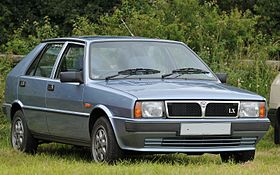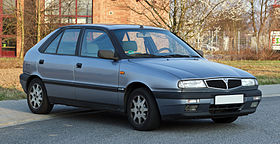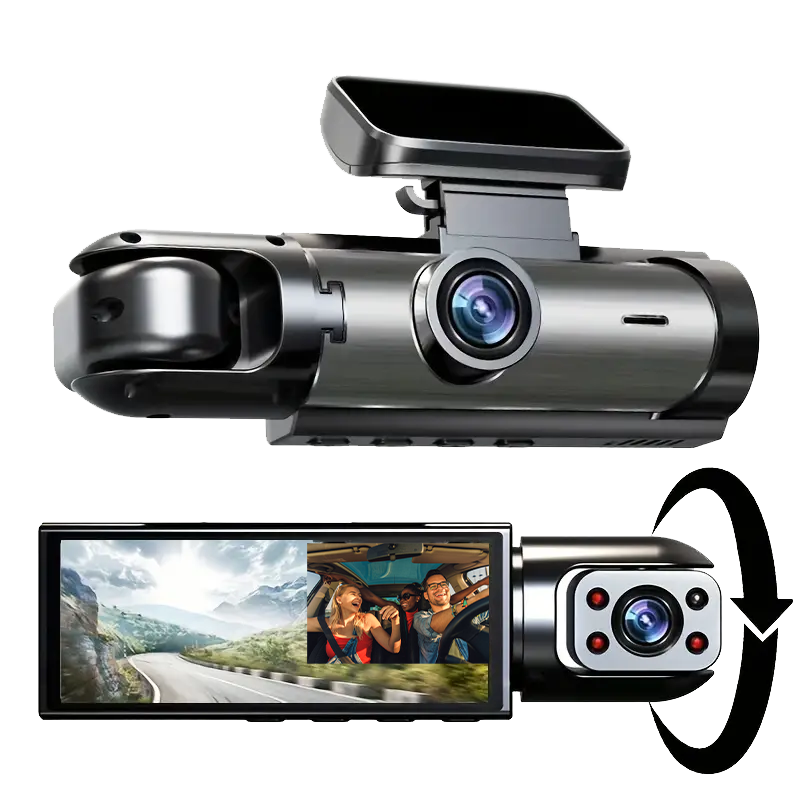
Lancia Delta Second Generation 1993–1999

| Lancia Delta | |
|---|---|

Lancia Delta LX 1.3 (first generation, 1986–91 model)
|
|
| Overview | |
| Manufacturer | Lancia |
| Production | 1979–1999 2008–2014 |
| Body and chassis | |
| Class | Small family car (C) |
| Body style | Hatchback |
The Lancia Delta is a small family car produced by Italian automobile manufacturer Lancia in three generations.
The first generation produced between 1979 and 1994, the second generation from 1993 to 1999, and the third generation from 2008 to 2014The Delta was first shown at the Frankfurt Motor Show in 1979. The Delta dominated the World Rally Championship during the late 1980s and early 1990s. The homologation requirements of Group A regulations meant marketing road-going versions of these competition cars — the Lancia Delta HF 4WD and HF Integrale. A total of 44,296 Integrales were produced.
| Second generation | |
|---|---|
 |
|
| Overview | |
| Production | 1993–1999 |
| Assembly | Pomigliano d'Arco, Naples |
| Designer | Ercole Spada at I.DE.A |
| Body and chassis | |
| Body style |
|
| Layout | Transverse front-engine, front-wheel-drive |
| Platform | Fiat Type Two (Tipo Due) platform |
| Related |
|
| Powertrain | |
| Engine |
|
| Transmission | 5-speed manual |
| Dimensions | |
| Wheelbase | 2,540 mm (100 in) |
| Length | 4,011 mm (157.9 in) |
| Width |
|
| Height | 1,430 mm (56 in) |
| Kerb weight | 1,130–1,330 kg (2,491–2,932 lb) |
The successor to the original Delta, the "Nuova Delta" (Tipo 836)—always referred to by Lancia as Lancia δ with the lower-case Greek letter—was introduced in 1993 and remained in production until 1999. It was designed at Turinese design and engineering studio I.DE.A Institute by Ercole Spada. Based on the "Type Two" platform of the Fiat Tipo, the Nuova Delta was targeted at customers more interested in comfort and convenience. Despite front-wheel drive HF performance variants with up to 193 PS (142 kW; 190 hp) were offered, no four-wheel drive second generation Deltas were even produced.
History
The first generation Delta had been given a second lease of life by its rallying successes, but by the 1990s it was over ten years old and due replacement; its four-door saloon sibling, the Prisma, had already been replaced by the Lancia Dedra. Development and tooling work for the Tipo 836 Delta lasted five years and, according to a statement by Fiat CEO Paolo Cantarella, required an investment of 700 billion Lire. Projected sales numbers were 60,000 a year, half of them exports.
Launch
The second generation Delta's world première was held at the March 1993 Geneva Motor Show, alongside that of the final "Evo 2" HF Integrale. Sales commenced in May. Initially the Nuova Delta was offered with three engines and outputs varying from 76 to 142 PS (56 to 104 kW; 75 to 140 hp): an entry level SOHC 1.6-litre, and two DOHC inline fours with Lancia's twin counter rotating balance shafts, an 8-valve 1.8 L and a 16-valve 2.0 L. Trim level were three: base and LE for the 1.6 and 1.8, base and richer LS for two-litre models. The sportier 2.0 HF was also unveiled in Geneva, but went on sale in September; it used a version of the 16-valve 2.0 L equipped with a Garrett T3 turbocharger and an intercooler to produce 186 PS (137 kW; 183 hp). Mechanical changes from the other Deltas included up-sized 205/50 tyres, stiffer suspension, standard 4-way ABS, a "Viscodrive" viscous coupling limited slip differential and, in the HF LS trim, electronically adjustable dampers with two settings. Visually the HF turbo was set apart by an eggcrate grille with a gunmetal surround and a yellow HF badge, a sportier front bumper complementing 2.8 cm (1.1 in) wider front wings, black side skirts, specific 15 inch 7-spoke alloy wheels and a spoiler at the base of the rear window. Larger disk brakes and optional Alcantara Recaro sport seats were shared with the 2.0 LS. About a year after the launch, in June 1994, the 1.9 turbo ds turbodiesel variant was added to the range; it was powered by the usual 1,929 cc SOHC unit, pushing out 90 PS (66 kW; 89 hp). The turbo ds was given the flared fenders and bumper of the HF, and was available in base and LE trim. Presented a month later and put on sale in autumn, the Delta 2.0 GT paired the naturally aspirated 2-litre engine with the looks of the HF—flared fenders, bumper and spoiler.

The HPE
Despite a three-door had been rumoured since 1991, until 1995 only a five-door hatchback body style was offered. At the 1995 Geneva Motor Show the three-door was introduced, christened HPE—a denomination that had previously been used for a shooting brake variant of the Lancia Beta, and standing for "High Performance Executive". At first the HPE was only available with the three top engines: 2.0 16v, 1.9 turbodiesel and 2.0 16v turbo in HF guise. The three-door bodyshell had entirely redesigned body sides, but retained the roof and rear section of the five-door model; rear wheelarch flares complemented the HF-derived wide front wings and bumper, sported by all HPE versions. This meant the HPE was around 6 cm (2.4 in) wider than a standard Delta, while all other exterior dimensions remained unchanged. Styling differences from the five-door included specific side skirts and a body-colour grille, to which the HPE 2.0 HF added all the accoutrements of the five-door HF and additional air intakes under the headlights.
1996 revisions
At the beginning of 1996 the range was updated. All naturally aspirated engines were replaced; the 1.6 and 1.8 8-valve by 16-valve units, while the 2.0 16v was discontinued in favour of a 1.8 16v equipped with variable valve timing. Trim levels for the 5-door were now three: base LE, richer LX and GT, exclusive to the 1.8 V.V.T. engine. The three-door HF turbo remained the only one offered, as the five-door version was discontinued. In addition to the turbocharged engines, the HPE was available with 1.8 V.V.T. and also the smaller 1.6 engines; the latter, entry level HPE adopted the bumper and narrow front wings of the standard Delta. Minor styling changes were introduced, such as alloy wheels and wheel covers of a new design, chrome vertical bars to the 5-door cars' grille, and body colour mirror caps.

1997 revisions
November 1997 brought the last revisions for the Delta. Seven models made up the updated range: 5-door and HPE with a choice of 1.6, 1.8 V.V.T. or 1.9 td engines—the 2.0 16v having been phased out—and a renewed 2.0 HF, again in HPE form only. The 5-door range was reduced to a single LS trim. More of the plastic exterior details were now painted in body colour, namely bumper, bodyside and C-pillar inserts. All HPEs donned flared front wings. The updated HPE 2.0 HF was shown at the Bologna Motor Show in November. Visually it continued the monochrome theme of the restyled cars, and it was made more distinctive by bumpers, side skirts, and spoiler of a new design, and 16 inch Speedline Montecarlo alloy wheels with 215/50 tyres; inside the seats were upholstered in black leather with contrasting colour Alcantara centres. Mechanically it received a tweaked engine, producing 193 PS (142 kW; 190 hp), which made for a 5 km/h higher top speed.
The Delta was dropped from Lancia's lineup in 1999, with no immediate successor. The related but more successful Dedra saloon was replaced at the same time by the Lybra, a compact executive car not offered with a hatchback body style.
Specifications

Being based on Fiat's Tipo 2 (Type Two) architecture, the second generation Delta featured a steel unibody construction, transverse engine, and all-independent suspension. At the front these were of the MacPherson strut type—the lower arms linked to the same subframe which supported the drivetrain—with coaxial coil springs and telescopic dampers, and an anti-roll bar; at the rear there were trailing arms (also connected to the body by a subframe), an anti-roll bar, coil springs and telescopic dampers. Steering was rack and pinion with standard hydraulic power steering. Brakes were discs on all four wheels, except for base 1.6 cars which used drums at the rear. All models used a 5-speed gearbox and were front-wheel drive.
Engines
| Model | Prod. period |
Layout | Displacement | Valvetrain | Fuel and intake systems | Peak power PS (kW bhp) |
Peak torque N·m (lb·ft) |
|
|---|---|---|---|---|---|---|---|---|
| Petrol engines | ||||||||
| 1.6 | 1993–96 | I4 | 1,581 cc | SOHC 8v | Monomotronic SPI | 75 (55; 74) at 6,000 rpm | 124 (91) at 3,000 rpm | |
| 1.6 16v | 1996–99 | I4 | 1,581 cc | DOHC 16v | Weber-Marelli IAW MPI | 103 (76; 102) at 5,750 rpm | 144 (106) at 4,000 rpm | |
| 1.8 | 1993–96 | I4, 2 BS | 1,756 cc | DOHC 8v | Weber-Marelli IAW MPI | 103 (76; 102) at 6,000 rpm | 137 (101) at 3,000 rpm | |
| 1.8 16v* | 1996–97 | I4, 2 BS | 1,747 cc | DOHC 16v | Weber-Marelli IAW MPI | 113 (83; 111) at 5,800 rpm | 154 (114) at 4,400 rpm | |
| 1.8 16v V.V.T. | 1996–99 | I4, 2 BS | 1,747 cc | DOHC 16v VVT | Hitachi phased sequential EFI | 130 (96; 128) at 6,300 rpm | 164 (121) at 4,300 rpm | |
| 2.0 16v | 1993–96 | I4, 2 BS | 1,995 cc | DOHC 16v | Weber-Marelli IAW MPI | 139 (102; 137) at 6,000 rpm | 180 (130) at 4,500 rpm | |
| HF turbo | 1993–96 | I4, 2 BS | 1,995 cc | DOHC 16v | Weber-Marelli IAW MPI, turbo intercooler | 186 (137; 183) at 5,750 rpm | 290 (210) at 3,500 rpm | |
| 2.0 HF** | 1997–99 | 193 (142; 190) at 5,500 rpm | 290 (210) at 3,400 rpm | |||||
| Diesel engines | ||||||||
| 1.9 turbo ds | 1994–96 | I4 | 1,929 cc | SOHC 8v | Bosch injection pump, turbo intercooler | 90 (66; 89) at 4,200 rpm | 186 (137) at 2,500 rpm | |
| 1.9 td | 1996–99 | |||||||
| Notes: * 5-door only; ** HPE only | ||||||||
Performance
| Model | 1.6 | 1.6 16v | 1.8 | 1.8 16v | 1.8 16v V.V.T. | 2.0 16v | HF turbo | 2.0 HF | 1.9 td |
|---|---|---|---|---|---|---|---|---|---|
| Top speed km/h (mph) | 172 (107) | 190 (118) | 185 [115] | 195 (121) | 200 (124) | 206 (128) | 220 (137) | 225 (140) | 180 (112) |
| Acceleration 0–100 km/h [0–62 mph] |
13.8 s | 11.0 s | 11.8 s | 10.3 s | 9.4 s | 9.6 s | 7.5 s | 7.5 s | 12.0 s |
